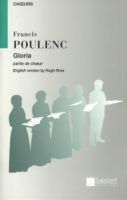Poulenc Gloria Vocal Score
 Vocal Scores for Poulenc's Gloria
Vocal Scores for Poulenc's Gloria
The Gloria by Francis Poulenc (FP 177), scored for soprano solo, large orchestra, and chorus, is a setting of the Roman Catholic Gloria in excelsis Deo text.
The most popular vocal scores for Poulenc's Gloria are shown below.
Rehearsal recordings to help learn your voice part (Soprano, Alto, Tenor, Bass) are described below.
Full video version to hear the work in full is also below.
This Salabert Edition of Poulenc's Gloria is in Latin for SATB

Catalogue Number:SLB00168800
ISMN:9790048001664
Please click here if you wish to order and further vocal score information
Please order by 3pm to be despatched today




This Salabert edition of Poulenc's Gloria is the chorus part and is in Latin and English text

Catalogue Number: SLB00168900
ISMN:9790048003460
Please click here if you wish to order and further vocal score information
Please order by 3pm to be despatched today
The Gloria by Francis Poulenc (FP 177), scored for soprano solo, large orchestra, and chorus, is a setting of the Roman Catholic Gloria in excelsis Deo text. One of Poulenc's most celebrated works, the Gloria was commissioned by the Koussevitsky Foundation in honor of Sergei Koussevitzky and his wife Natalia, the namesakes of the foundation. It was premiered on January 21, 1961 in Boston, MA by the Boston Symphony Orchestra and the Chorus Pro Musica under conductor Charles Münch with Adele Addison as soloist. The first recording (also in 1961), for EMI, was conducted by Georges Prêtre, under the supervision of the composer. Among later recordings of the music, the RCA Victor recording by the Robert Shaw Chorale in 1965 won a Grammy Award for the "Best Choral Performance."
The work is divided into six movements as follows:
* 1. Gloria in excelsis Deo (G major)
* 2. Laudamus te (C major)
* 3. Domine Deus, Rex caelestis (B minor)
* 4. Domine Fili unigenite (G major)
* 5. Domine Deus, Agnus Dei (B-flat minor)
* 6. Qui sedes (G major)
The first movement opens with a great chordal motif from the brass instruments, and the chorus enters singing in an accented and declamatory manner. The introduction begins in G major and modulates to a G minor chord, after which the woodwinds enter in parallel 4ths and 7ths. The chorus enters in double-dotted rhythms, reminiscent of the brass fanfare, in the key of B minor, accompanied by B minor triads over a pedal G in the bass. This relationship of juxtaposition between G major and B minor is an important one that returns throughout the piece.
The second movement is the most jocund, opening with a strange, quick brass introduction. A light tune repeats throughout this movement along with an often-changing time signature. This movement is in the key of C, with a few diversions throughout. The last line of the text, beginning "Gratias agimus..." is in a chromaticized mode, giving an other-worldly characteristic in the middle of the revelry of the movement. After this respite, there is a diversion to E flat over an "oompah" bass figure. The accentuation of the text in this movement has been referred to as "perverse", due to its un-speechlike patterns.
The third movement is led by the extremely dramatic solo soprano line after a woodwind introduction. The movement ends with a picardy third, preparing the way for the more joyful fourth movement.
The fourth movement is the shortest and resembles the second movement in the jocular nature of the orchestral phrases, but contains some of the accented nature of the first movement in the chorus parts. The melodic lines are often pentatonic, and the quick tempo and rousing rhythms give a whirling and dancing impression, grounded by the constant return of the theme.
The fifth movement opens with woodwinds and resembles the third movement with the return of the soprano soloist as leader. The music is dark and mysterious, due in part to the inclusion of both an augmented fourth and an augmented fifth in the soprano's opening melodic line. The movement culminates in an E-flat minor chord, a fifth lower than the beginning B-flat minor, giving an uneasy, mysterious feeling to the end. Of particular note is the similarity between the clarinet solos of this movement and part of the first movement of Poulenc's later clarinet sonata.
The sixth movement begins with alternating a cappella chorus and interjections of the orchestra intoning the fanfare theme from the first movement. After the introduction, the main setting of the text is reminiscent of the first movement, with the sixteenth note toiling line in the upper strings above a walking bass. The final section is preceded by a solo "Amen" from the soprano, echoed by the chorus. The chorus proceeds to repeat the text, this time over a mixture of B minor and G major chords in the orchestra. The fanfare theme from the first movement returns one final time before the final "Amen", triumphantly slower and grander. The final "Amen" intoned by the soprano on a D relates to both the B minor and G major chords played simultaneously to end the piece.
For further information of Poulenc's Gloria, please click here to visit the Wikipedia website




ChoraLine 'Voice Part' Rehearsal CDs & EasyPlay (Stream & Download)
Quick and Easy way to memorise your vocal line and practise between choir rehearsals

Know Your Notes Perfectly
Enhance Your Enjoyment when Singing
Learn With The Music
Shine In Your Choir
Sing With Confidence
Please click here to hear a ChoraLine sample for Gloria








